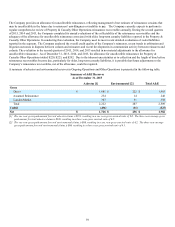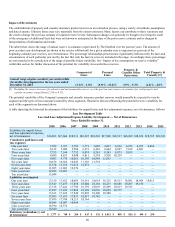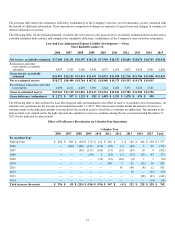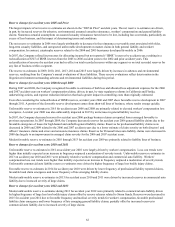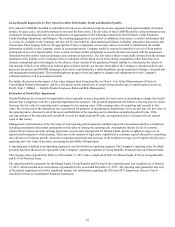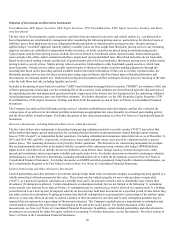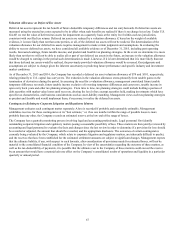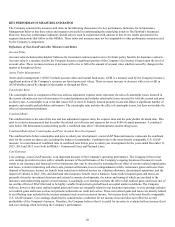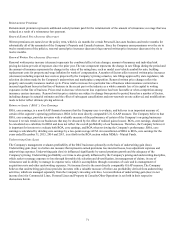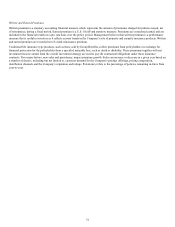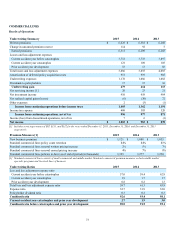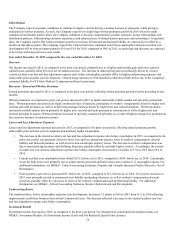The Hartford 2015 Annual Report Download - page 64
Download and view the complete annual report
Please find page 64 of the 2015 The Hartford annual report below. You can navigate through the pages in the report by either clicking on the pages listed below, or by using the keyword search tool below to find specific information within the annual report.64
For most annuity contracts, the Company estimates gross profits over 20 years as EGPs emerging subsequent to that time frame are
immaterial. Products sold in a particular year are aggregated into cohorts. Future gross profits for each cohort are projected over the
estimated lives of the underlying contracts, based on future account value projections for variable annuity products. The projection of
future account values requires the use of certain assumptions including: separate account returns; separate account fund mix; fees
assessed against the contract holder’s account balance; surrender and lapse rates; interest margin; mortality; and the extent and duration
of hedging activities and hedging costs. Changes in these assumptions and changes to other policyholder behavior assumptions such as
resets, partial surrenders, reaction to price increases, and asset allocations cause EGPs to fluctuate, which impacts earnings.
The Company determines EGPs from a single deterministic reversion to mean (“RTM”) separate account return projection which is an
estimation technique commonly used by insurance entities to project future separate account returns. Through this estimation technique,
the Company’s DAC model is adjusted to reflect actual account values at the end of each quarter. Through consideration of recent
market returns, the Company will unlock, or adjust, projected returns over a future period so that the account value returns to the long-
term expected rate of return, providing that those projected returns do not exceed certain caps. The Unlock for future separate account
returns is determined each quarter. Under RTM, the expected long term weighted average rate of return is 8.3%.
In the fourth quarter of 2015, the Company completed a comprehensive policyholder behavior assumption study which resulted in a non-
market related after-tax benefit of $9 and incorporated the results of that study into its projection of future gross profits. Additionally,
throughout the year, the Company evaluates various aspects of policyholder behavior and will revise its policyholder assumptions if
credible emerging data indicates that changes are warranted. The Company will continue to evaluate its assumptions related to
policyholder behavior as initiatives to reduce the size of the annuity business are implemented by management. Upon completion of an
annual assumption study or evaluation of credible new information, the Company will revise its assumptions to reflect its current best
estimate. These assumption revisions will change the projected account values and the related EGPs in the DAC and SIA amortization
models, as well as the death and other insurance benefit reserving model.
All assumption changes that affect the estimate of future EGPs including the update of current account values, the use of the RTM
estimation technique and policyholder behavior assumptions are considered an Unlock in the period of revision. An Unlock adjusts
DAC, SIA, and death and other insurance benefit reserve balances in the Consolidated Balance Sheets with an offsetting benefit or
charge in the Consolidated Statements of Operations in the period of the revision. An Unlock that results in an after-tax benefit generally
occurs as a result of actual experience or future expectations of product profitability being favorable compared to previous estimates. An
Unlock that results in an after-tax charge generally occurs as a result of actual experience or future expectations of product profitability
being unfavorable compared to previous estimates.
EGPs are also used to determine the expected excess benefits and assessments included in the measurement of death and other insurance
benefit reserves. These excess benefits and assessments are derived from a range of stochastic scenarios that have been calibrated to the
Company’s RTM separate account returns. The determination of death and other insurance benefit reserves is also impacted by discount
rates, lapses, volatilities, mortality assumptions and benefit utilization, including assumptions around annuitization rates.
In addition to updating assumptions in the fourth quarter of each year, an Unlock revises EGPs, on a quarterly basis, to reflect the
Company’s current best estimate assumptions and market updates of policyholder account value. Modifications to the Company’s
hedging programs may impact EGPs, and correspondingly impact DAC recoverability. After each quarterly Unlock, the Company also
tests the aggregate recoverability of DAC by comparing the DAC balance to the present value of future EGPs. The margin between the
DAC balance and the present value of future EGPs for variable annuities was 40% as of December 31, 2015. If the margin between the
DAC asset and the present value of future EGPs is exhausted, then further reductions in EGPs would cause portions of DAC to be
unrecoverable and the DAC asset would be written down to equal future EGPs.
Evaluation of OTTI on Available-for-Sale Securities and Valuation Allowances on Mortgage Loans
The Company has a monitoring process that is overseen by a committee of investment and accounting professionals which identifies
investments that are subject to an enhanced evaluation on a quarterly basis to determine if an other-than-temporary impairment
(“impairment”) is present for AFS securities or a valuation allowance is required for mortgage loans. This evaluation is a quantitative
and qualitative process, which is subject to risks and uncertainties. For further discussion of the accounting policies, see the Significant
Investment Accounting Policies Section in Note 1 - Basis of Presentation and Significant Accounting Policies of Notes to Consolidated
Financial Statements. For a discussion of impairments recorded, see the Other-Than-Temporary Impairments within the Investment
Portfolio Risks and Risk Management section of the MD&A.







